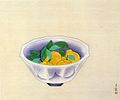Kokei Kobayashi
From Wikipedia, the free encyclopedia
Kokei Kobayashi (小林古径, Kobayashi Kokei, February 11, 1883 – March 3, 1957) was a Japanese Nihonga painter.[1]
You can help expand this article with text translated from the corresponding article in German. (May 2019) Click [show] for important translation instructions.
|
Kokei Kobayashi | |
|---|---|
 circa 1953 | |
| Born | Shigeru Kobayashi February 11, 1883 Takada, Niigata Prefecture, Japan |
| Died | April 3, 1957 (aged 74) |
| Nationality | Japanese |
| Education | Kajita, Hanko |
| Known for | Painter |
| Movement | Nihonga |
| Awards | Order of Culture(1950), Person of Cultural Merit(1951) |
Biography
He became an orphan early in his life, at the age of 17 he moved to Tokyo and studied traditional Japanese painting at Kajita Hanko.[2] Later he became one of the most notable members in the Restored Japan Academy of Art.[3]
Initially, he painted traditional subject matter ("Taketori monogatari"-1914 as an example) but later he continued with still life and contemporary scenes. His famous works include: "Amida-dō" (1914), "Ideyu" (1918) and "Kami" (1931).[3]
He was friends with Tamako Kataoka (1905–2008).
He was awarded the Order of Culture.
Works
- Fruit (1910)
- In the Bath (1918)
- Magnolia Tree (1919)
- Hair (Unknown Date)
- Turkey (1928)
- White flowers and bird (1930s)
- "Cherry Blossom" (1930s)
- Crane (1928)
See also
- Seison Maeda (1885–1977), one of the leading Nihonga painters
- List of Nihonga painters
References
External links
Wikiwand - on
Seamless Wikipedia browsing. On steroids.







